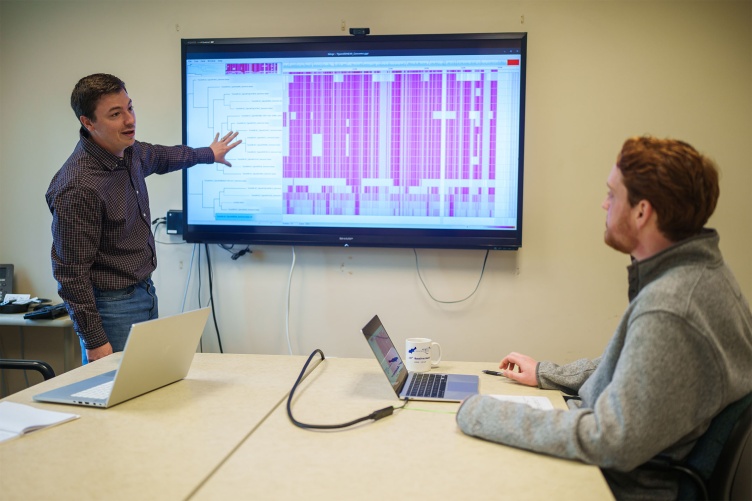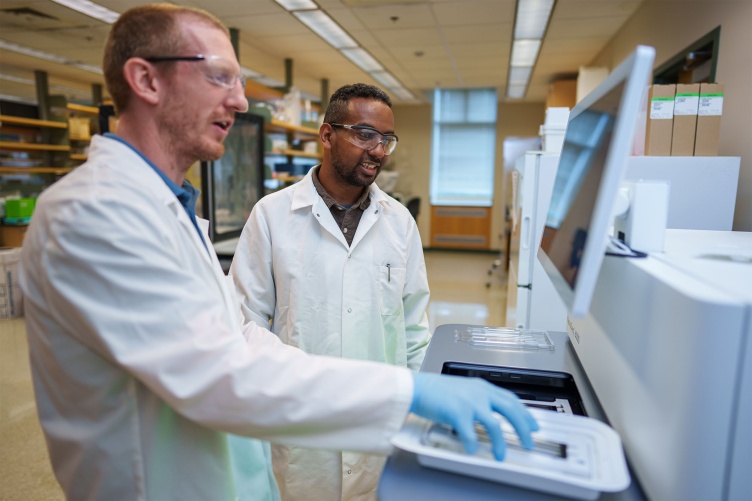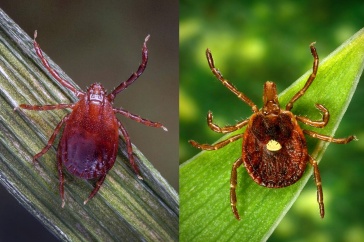The increasingly popular “One Health” model represents a holistic approach to sustaining and supporting health. It highlights the interconnectedness of human, animal and environmental health and recognizes that these elements are inextricably linked. This model of growing global interest emphasizes the importance of coordinating responses to health threats by sharing databases, surveillance and innovative solutions to address the root causes of risks and their impacts — and the connections between them.
“The ‘One Health’ model offers an important framework for the science that we do at the Hubbard Center,” explains W. Kelley Thomas, director of the Hubbard Center for Genome Studies (HCGS). “Whether we’re using DNA and RNA sequencing to monitor for human, plant, animal or environmental health, genomics can play a powerful role in that process.”
During the pandemic, the HCGS was instrumental in monitoring coronavirus and its variants. But, says Thomas, pathogenic threats aren’t just a concern for humans.
“Viruses pose a threat to our food supply, our pets, and our wildlife, and new technologies available through the Hubbard Center make identifying those potential threats possible,” he says.
Animal and Human Health
A significant rise in tick-borne diseases threatens the health of humans and domesticated and wild animals in northern New England.
“In the past, tick-borne illnesses, and even ticks themselves, were not a large concern for clinical practices in this region,” comments David Needle, a senior veterinary pathologist with the New Hampshire Veterinary Diagnostic Laboratory (NHVDL). “Today, veterinarians are engulfed in work related to the increased burden of ticks and tick-borne diseases that infect domesticated and wild animals — and tick prevention is now a vital part of veterinary care for companion animals and livestock.”
To sequence genomic data from ticks found on deer, moose, bears and other furbearers, as well as birds and bats, scientists from the HCGS and the NHVDL will soon begin extracting DNA and RNA from individual ticks and from the blood that these ticks take from host animals. This will inform future epidemiological studies on the spread of tick-transmitted diseases in the region, and state agencies can use the data to ramp up education and control efforts in high-risk areas and mitigate the growing health threat of tick-borne illnesses.
“Viruses pose a threat to our food supply, our pets, and our wildlife, and new technologies available through the Hubbard Center make identifying those potential threats possible.” ~ W. Kelley Thomas, professor of Molecular, Cellular, and Biomedical Sciences
In another recent collaboration with the NHVDL, scientists at the HCGS helped identify a previously unknown bacterium potentially linked to a canine respiratory syndrome. This discovery marked a critical step in understanding and combating an illness that began perplexing U.S. veterinarians in August 2023.
The illness, which has affected hundreds of dogs across several states, including New Hampshire, presents symptoms such as persistent cough, runny eyes and sneezing. In severe cases, it can escalate to acute pneumonia, and a small subset of dogs have died from the illness. A key observation came when HCGS scientists, analyzing genetic samples from 70 dogs in New Hampshire, Rhode Island and Massachusetts, noticed a small portion of the genome from an atypical bacterial species. Lawrence Gordon ’26G, a graduate research assistant at the HCGS, played a pivotal role in this discovery, identifying a common genetic segment in most of the samples.
"Very little is known about this bacterium so far, so understanding why it's present in some of these samples and how it might be causing infection is just as crucial as its identification," said Gordon.
Human Nutrition and Health
With support from the HCGS, Maria Carlota Dao, an assistant professor of agriculture, nutrition and food systems at COLSA, is using genomic sequencing to unravel the complex connections between diet, the gut microbiome and human health. Her investigation is particularly vital in understanding the health dynamics of Hispanic/Latino communities, which are disproportionately affected by obesity and related chronic diseases.
Dao's research examines the dietary habits of Hispanic adults, particularly those eligible for SNAP benefits, assessing fiber intake and its role in metabolism and appetite regulation. Dao and her team are also assessing food insecurity, dietary intake and gut microbiota in study participants, adopting a comprehensive approach necessary for developing targeted, culturally tailored nutritional interventions.
“This study will also reveal opportunities to make our food systems and nutrition assistance programs better equipped to serve the state’s Hispanic/Latino communities,” Dao says.
Plant Health
In the area of plant pathogen monitoring, the HCGS is helping to identify the origins and progression of the diseases that are most devastating to our environment and our crops. For example, by analyzing the DNA of the fungi associated with beech bark disease — which is caused by the combined effects of specific insects and fungi and has been attacking American beech trees across North America for more than a century — the HCGS is working to reveal some of the mechanisms behind this disease.
Leading the research is Jeff Garnas, associate professor of forest ecosystem health, and Eric Morrison ’09 ’12G ’17G, a research scientist. Their research has involved collecting strains of the different BBD fungal microbes from 17 locations across New England, New York, New Jersey, the Mid-Atlantic and Michigan. By studying the isolates gathered from the fungal strains that contribute to BBD, Garnas and Morrison can track its progression across North America and correlate their findings with other data sets, like temperature changes and climate models.
“One thing that we’re trying to identify are any adaptations to warmer temperatures that may have occurred during the dispersal of fungus from Canada over the last few decades,” says Morrison. “If we can identify which mutations are adaptive to warmer temperatures, then we can begin identifying which genes are involved in that adaptation and potentially predict which fungus might be more successful in warmer temperatures.”
This genomic research supported by the HCGS is not only critical for battling beech bark disease, but also serves as a model for monitoring other plant diseases. By establishing a genomic framework for pathogens, the center’s team contributes significantly to global conservation efforts and sustainable forestry. This work illustrates the critical role of genomics in environmental monitoring and protection and in addressing ecological threats to biodiversity.
Discover more about the revolutionary 'One Health' model and the cutting-edge genomic research at the Hubbard Center for Genome Studies. Visit the HCGS website to explore its projects, services, and the impact of its work on global health and the environment.
-
Written By:
Nicholas Gosling '06 | COLSA/NH Agricultural Experiment Station | nicholas.gosling@unh.edu




















































